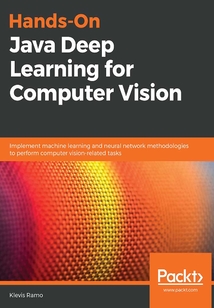舉報 

會員
Hands-On Java Deep Learning for Computer Vision
Althoughmachinelearningisanexcitingworldtoexplore,youmayfeelconfusedbyallofitstheoreticalaspects.AsaJavadeveloper,youwillbeusedtotellingthecomputerexactlywhattodo,insteadofbeingshownhowdataisgenerated;thiscausesmanydeveloperstostruggletoadapttomachinelearning.ThegoalofthisbookistowalkyouthroughtheprocessofefficientlytrainingmachinelearninganddeeplearningmodelsforComputerVisionusingthemostup-to-datetechniques.Thebookisdesignedtofamiliarizeyouwithneuralnetworks,enablingyoutotrainthemefficiently,customizeexistingstate-of-the-artarchitectures,buildreal-worldJavaapplications,andgetgreatresultsinashortspaceoftime.Youwillbuildreal-worldComputerVisionapplications,rangingfromasimpleJavahandwrittendigitrecognitionmodeltoreal-timeJavaautonomouscardrivingsystemsandfacerecognitionmodels.Bytheendofthisbook,youwillhavemasteredthebestpracticesandmoderntechniquesneededtobuildadvancedComputerVisionJavaapplicationsandachieveproduction-gradeaccuracy.
目錄(123章)
倒序
- coverpage
- Title Page
- Copyright and Credits
- Hands-On Java Deep Learning for Computer Vision
- About Packt
- Why subscribe?
- Packt.com
- Contributor
- About the author
- Packt is searching for authors like you
- Preface
- Who this book is for
- What this book covers
- To get the most out of this book
- Download the example code files
- Download the color images
- Conventions used
- Get in touch
- Reviews
- Introduction to Computer Vision and Training Neural Networks
- The computer vision state
- The importance of data in deep learning algorithms
- Exploring neural networks
- Building a single neuron
- Building a single neuron with multiple outputs
- Building a neural network
- How does a neural network learn?
- Learning neural network weights
- Updating the neural network weights
- Advantages of deep learning
- Organizing data and applications
- Organizing your data
- Bias and variance
- Computational model efficiency
- Effective training techniques
- Initializing the weights
- Activation functions
- Optimizing algorithms
- Configuring the training parameters of the neural network
- Representing images and outputs
- Multiclass classification
- Building a handwritten digit recognizer
- Testing the performance of the neural network
- Summary
- Convolutional Neural Network Architectures
- Understanding edge detection
- What is edge detection?
- Vertical edge detection
- Horizontal edge detection
- Edge detection intuition
- Building a Java edge detection application
- Types of filters
- Basic coding
- Convolution on RGB images
- Working with convolutional layers' parameters
- Padding
- Stride
- Pooling layers
- Max pooling
- Average pooling
- Pooling on RGB images
- Pooling characteristics
- Building and training a Convolution Neural Network
- Why convolution?
- Improving the handwritten digit recognition application
- Summary
- Transfer Learning and Deep CNN Architectures
- Working with classical networks
- LeNet-5
- AlexNet
- VGG-16
- Using residual networks for image recognition
- Deep network performance
- ResNet-50
- The power of 1 x 1 convolutions and the inception network
- Applying transfer learning
- Neural networks
- Building an animal image classification – using transfer learning and VGG-16 architecture
- Summary
- Real-Time Object Detection
- Resolving object localization
- Labeling and defining data for localization
- Object localization prediction layer
- Landmark detection
- Object detection with the sliding window solution
- Disadvantages of sliding windows
- Convolutional sliding window
- Detecting objects with the YOLO algorithm
- Max suppression and anchor boxes
- Max suppression
- Anchor boxes
- Building a real-time video car and pedestrian detection application
- Architecture of the application
- YOLO V2-optimized architecture
- Coding the application
- Summary
- Creating Art with Neural Style Transfer
- What are convolution network layers learning?
- Neural style transfer
- Minimizing the cost function
- Applying content cost function
- Applying style cost function
- How to capture the style
- Style cost function
- Building a neural network that produces art
- Summary
- Face Recognition
- Problems in face detection
- Face verification versus face recognition
- Face verification
- Face recognition
- One-shot learning problem
- Similarity function
- Differentiating inputs with Siamese networks
- Learning with Siamese networks
- Exploring triplet loss
- Choosing the triplets
- Binary classification
- Binary classification cost function
- Building a face recognition Java application
- Summary
- Other Books You May Enjoy
- Leave a review - let other readers know what you think 更新時間:2021-07-02 13:26:14
推薦閱讀
- Mastering Ninject for Dependency Injection
- 劍破冰山:Oracle開發(fā)藝術(shù)
- 輕松學大數(shù)據(jù)挖掘:算法、場景與數(shù)據(jù)產(chǎn)品
- 工業(yè)大數(shù)據(jù)分析算法實戰(zhàn)
- 商業(yè)分析思維與實踐:用數(shù)據(jù)分析解決商業(yè)問題
- 數(shù)據(jù)庫系統(tǒng)原理及應用教程(第4版)
- 數(shù)據(jù)庫應用基礎教程(Visual FoxPro 9.0)
- iOS and OS X Network Programming Cookbook
- Power BI智能數(shù)據(jù)分析與可視化從入門到精通
- 貫通SQL Server 2008數(shù)據(jù)庫系統(tǒng)開發(fā)
- R Object-oriented Programming
- 活用數(shù)據(jù):驅(qū)動業(yè)務的數(shù)據(jù)分析實戰(zhàn)
- 信息融合中估計算法的性能評估
- 智能與數(shù)據(jù)重構(gòu)世界
- Microsoft Dynamics NAV 2015 Professional Reporting
- 數(shù)據(jù)挖掘算法實踐與案例詳解
- MySQL性能調(diào)優(yōu)與架構(gòu)設計
- 數(shù)據(jù)會說話:活用數(shù)據(jù)表達、說服與決策
- Hands-On Java Deep Learning for Computer Vision
- Learning Construct 2
- 大數(shù)據(jù)原理與技術(shù)
- Access數(shù)據(jù)庫教程(2010版)
- MySQL必知必會
- Java Deep Learning Essentials
- SQL必知必會(第4版)
- 短文本數(shù)據(jù)理解
- 指標體系與指標平臺:方法與實踐
- Python:Advanced Predictive Analytics
- 數(shù)據(jù)自助服務實踐指南:數(shù)據(jù)開放與洞察提效
- 智能數(shù)據(jù)治理:基于大模型、知識圖譜

